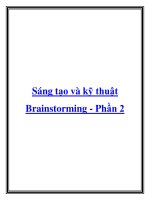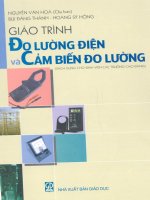Tài liệu cảm biến và kỹ thuật đo lường lecture 9 flow sensors
Bạn đang xem bản rút gọn của tài liệu. Xem và tải ngay bản đầy đủ của tài liệu tại đây (99.42 KB, 7 trang )
Lecture #9
Basic Intent
To gain knowledge of flowsensors.
Flow Sensors
There are three basic approaches to the measurement of flow. The first of these categories
involves the use of thermal effects to measure fluid motion. In general, this approach uses
a heat source to deposit heat into the fluid, and a thermometer to measure the temperature
of the fluid. If the heat source is upstream of the sensor, flow increases heat transport and
causes the sensor temperature to increase. Another possible arrangement is to heat a
thermistor with a fixed power, and measure its temperature. In this case, fluid flow acts to
cool the thermometer.
These approaches can be analyzed to predict the sensitivity of such a system. In general,
the fluid flow around a real physical system is very difficult to model, and the resulting
performance generally needs to be calibrated. In addition, non-linear effects in turbulent
flow can cause severe nonlinearities. Nevertheless, such an arrangement is easy to
assemble, and inexpensive thermistors enable such systems to be produced at low cost.
properly calibrated, such systems are capable of excellent performance, and are in wide
use in industry.
A slightly more complicated approach relies on Bernoulli's Equation, which is:
This roughly states that the Pressure + the kinetic energy density + the gravitational
potential energy density is a constant throughout a fluid. This principle is applied by
measuring pressure at a pair of points in a fluid. When water flows through a pipe with a
varying diameter, the total flow rate in each region is a constant (since the fluid must all
get through the tube). Therefore, changes in tube diameter are compensated for by
changes in fluid velocity. By measuring the pressure in regions with different diameter, it
is possible to measure fluid velocity.
Now, the textbook section (P. 394) which describes this technique is not completely
accurate. Whereas the drawings and the text discuss measuring pressure drop across a
flow impedance (much like a resistor - relies on dissipation in the impedance to produce a
pressure drop), the equations all describe a Bernoulli principle, in which a velocity
change is being measured. It is important to understand this distinction:
Bernoulli's equation techniques only work if the flow is not turbulent (non-dissipative).
Then the pressure difference is between the wide and narrow regions (see equations in
text).
Pressure drop techniques only work if the flow is turbulent (dissipative). Then the
pressure difference is across the dissipative region (see figures and words in text).
Fig. 1: Capacitive Pressure Sensor
Fig. 1 (Fig. 10-16 in the text) does show a proper configuration for a Bernoulli flow
sensor. Here, flow induces a pressure difference across a silicon diaphragm which
separates a wide channel from a narrow channel.
The last technique for flow measurement is based on measurement of Doppler effects in
sound transport. Since sound is carried by pressure waves in a medium (the fluid), its
transport laterally across a channel is affected by the motion of the fluid. It is possible to
measure the change in sound frequency due to fluid motion (direct Doppler effect), or
listen for changes in the travel time from transmitter to receiver. High sensitivity
techniques generally measure frequency shifts, since excellent accuracy may be obtained
by use of analog or digital signal processing techniques to measure small frequency
shifts.
To review, flow may be measured by thermal, Bernoulli, or Doppler techniques. Thermal
techniques are generally least accurate and least expensive, Bernoulli techniques can
work well, but are accurate only for non-turbulent flow, and Doppler techniques are
potentially most accurate, but are also generally most expensive.
Some possible pictures to be used in the development of these pages:
Fig. : Float-type flow meter.
Fig. : Turbine flow meter.
Fig. : Nozzle flow meter in duct.
Fig. : Orifice, flow nozzle, and venturi flow meters.
Fig. : U-tube manometer.
Fig. : Wall pressure tap for static pressure measurement.
Fig. 1: Static pressure probe.
Fig. :Simultaneous measurement of stagnation and static pressures.









